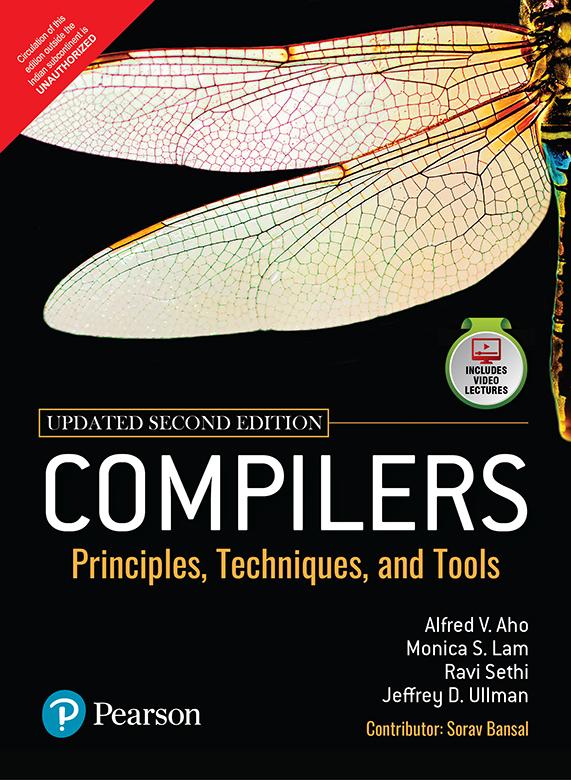

About Pearson
Pearson is the world’s learning company, with presence across 70 countries worldwide. Our unique insights and world-class expertise comes from a long history of working closely with renowned teachers, authors and thought leaders, as a result of which, we have emerged as the preferred choice for millions of teachers and learners across the world.
We believe learning opens up opportunities, creates fulfilling careers and hence better lives. We hence collaborate with the best of minds to deliver you class-leading products, spread across the Higher Education and K12 spectrum.
Superior learning experience and improved outcomes are at the heart of everything we do. This product is the result of one such effort.
Your feedback plays a critical role in the evolution of our products and you can contact us - reachus@pearson.com. We look forward to it.
COMPILERS
PRINCIPLES, TECHNIQUES, AND TOOLS
Updated Second Edition
Alfred V. Aho
Columbia University
Monica S. Lam
Stanford University
Ravi Sethi
Avaya
Jeffrey D. Ullman
Stanford University
Contributor
Sorav Bansal
Indian Institute of Technology Delhi

Preface
About the Authors
Chapter 1 Introduction
1.1 Language Processors
1.2 The Structure of a Compiler
1.2.1 Lexical Analysis
1.2.2 Syntax Analysis
1.2.3 Semantic Analysis
1.2.4 Intermediate Code Generation
1.2.5 Code Optimization
1.2.6 Code Generation
1.2.7 Symbol-Table Management
1.2.8 The Grouping of Phases into Passes
1.2.9 Compiler-Construction Tools
1.3 The Evolution of Programming Languages
1.3.1 The Move to Higher-level Languages
1.3.2 Impacts on Compilers
1.4 The Science of Building a Compiler
1.4.1 Modeling in Compiler Design and Implementation
1.4.2 The Science of Code Optimization
1.5 Applications of Compiler Technology
1.5.1 Implementation of High-Level Programming Languages
1.5.2 Optimizations for Computer Architectures
1.5.3 Design of New Computer Architectures
1.5.4 Program Translations
1.5.5 Software Productivity Tools
1.6 Programming Language Basics
1.6.1 The Static/Dynamic Distinction
1.6.2 Environments and States
1.6.3 Static Scope and Block Structure
1.6.4 Explicit Access Control
1.6.5 Dynamic Scope
1.6.6 Parameter Passing Mechanisms
1.6.7 Aliasing
1.7 Summary of Chapter 1
1.8 References for Chapter 1
Chapter 2 A Simple Syntax-Directed Translator
2.1 Introduction
2.2 Syntax Definition
2.2.1 Definition of Grammars
2.2.2 Derivations
2.2.3 Parse Trees
2.2.4 Ambiguity
2.2.5 Associativity of Operators
2.2.6 Precedence of Operators
2.3 Syntax-Directed Translation
2.3.1 Postfix Notation
2.3.2 Synthesized Attributes
2.3.3 Simple Syntax-Directed Definitions
2.3.4 Tree Traversals
2.3.5 Translation Schemes
2.4 Parsing
2.4.1 Top-Down Parsing
2.4.2 Predictive Parsing
2.4.3 When to Use ϵ-Productions
2.4.4 Designing a Predictive Parser
2.4.5 Left Recursion
Compilers-Principles_-Techniques_-and-Tools_-Updated-2nd-Edition-_Alfred-V.-Aho
2.5 A Translator for Simple Expressions
2.5.1 Abstract and Concrete Syntax
2.5.2 Adapting the Translation Scheme
2.5.3 Procedures for the Nonterminals
2.5.4 Simplifying the Translator
2.5.5 The Complete Program
2.6 Lexical Analysis
2.6.1 Removal of White Space and Comments
2.6.2 Reading Ahead
2.6.3 Constants
2.6.4 Recognizing Keywords and Identifiers
2.6.5 A Lexical Analyzer
2.7 Symbol Tables
2.7.1 Symbol Table Per Scope
2.7.2 The Use of Symbol Tables
2.8 Intermediate Code Generation
2.8.1 Two Kinds of Intermediate Representations
2.8.2 Construction of Syntax Trees
2.8.3 Static Checking
2.8.4 Three-Address Code
2.9 Summary of Chapter 2
Chapter 3 Lexical Analysis
3.1 The Role of the Lexical Analyzer
3.1.1 Lexical Analysis Versus Parsing
3.1.2 Tokens, Patterns, and Lexemes
3.1.3 Attributes for Tokens
3.1.4 Lexical Errors
3.2 Input Buffering
3.2.1 Buffer Pairs
3.2.2 Sentinels
3.3 Specification of Tokens
3.3.1 Strings and Languages
3.3.2 Operations on Languages
3.3.3 Regular Expressions
3.3.4 Regular Definitions
3.3.5 Extensions of Regular Expressions
3.4 Recognition of Tokens
3.4.1 Transition Diagrams
3.4.2 Recognition of Reserved Words and Identifiers
3.4.3 Completion of the Running Example
3.4.4 Architecture of a Transition-Diagram-Based Lexical Analyzer
3.5 The Lexical-Analyzer Generator Lex
3.5.1 Use of Lex
3.5.2 Structure of Lex Programs
3.8 Design of a Lexical-Analyzer Generator Compilers-Principles_-Techniques_-and-Tools_-Updated-2nd-Edition-_Alfred-V.-Aho
3.5.3 Conflict Resolution in Lex
3.5.4 The Lookahead Operator
3.6 Finite Automata
3.6.1 Nondeterministic Finite Automata
3.6.2 Transition Tables
3.6.3 Acceptance of Input Strings by Automata
3.6.4 Deterministic Finite Automata
3.7 From Regular Expressions to Automata
3.7.1 Conversion of an NFA to a DFA
3.7.2 Simulation of an NFA
3.7.3 Efficiency of NFA Simulation
3.7.4 Construction of an NFA from a Regular Expression
3.7.5 Efficiency of String-Processing Algorithms
3.8.1 The Structure of the Generated Analyzer
3.8.2 Pattern Matching Based on NFA’s
3.8.3 DFA’s for Lexical Analyzers
3.8.4 Implementing the Lookahead Operator
3.9 Optimization of DFA-Based Pattern Matchers
3.9.1 Important States of an NFA
3.9.2 Functions Computed From the Syntax Tree
3.9.3 Computing nullable, firstpos, and lastpos
3.9.4 Computing followpos
3.9.5 Converting a Regular Expression Directly to a DFA
3.9.6 Minimizing the Number of States of a DFA
3.9.7 State Minimization in Lexical Analyzers
3.9.8 Trading Time for Space in DFA Simulation
3.10 Summary of Chapter 3
3.11 References for Chapter 3
Compilers-Principles_-Techniques_-and-Tools_-Updated-2nd-Edition-_Alfred-V.-Aho
Chapter 4 Syntax Analysis
4.1 Introduction
4.1.1 The Role of the Parser
4.1.2 Representative Grammars
4.1.3 Syntax Error Handling
4.1.4 Error-Recovery Strategies
4.2 Context-Free Grammars
4.2.1 The Formal Definition of a Context-Free Grammar
4.2.2 Notational Conventions
4.2.3 Derivations
4.2.4 Parse Trees and Derivations
4.2.5 Ambiguity
4.2.6 Verifying the Language Generated by a Grammar
4.2.7 Context-Free Grammars Versus Regular Expressions
4.3 Writing a Grammar
4.3.1 Lexical Versus Syntactic Analysis
4.3.2 Eliminating Ambiguity
4.3.3 Elimination of Left Recursion
4.3.4 Left Factoring
4.3.5 Non-Context-Free Language Constructs
4.4 Top-Down Parsing
4.4.1 Recursive-Descent Parsing
4.4.2 FIRST and FOLLOW
4.4.3 LL(1) Grammars
4.4.4 Nonrecursive Predictive Parsing
4.4.5 Error Recovery in Predictive Parsing
4.5 Bottom-Up Parsing
4.5.1 Reductions
4.5.2 Handle Pruning
